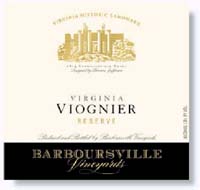This is a tale of two–no, three–wines. The first is a bottle that had gotten lost in my cellar, a 2005 Condrieu from Guigal. This wine had been delicious four years ago, when I last tried it. Made with Viognier grapes, it offered enticing honeysuckle and jasmine aromas, fresh stone fruit flavors, and a creamy texture, offering the beguiling combination of finesse married with weight that distinguishes this grape variety at its best.
The second wine is also a Viognier. This one was made by Barboursville Vineyards in Virginia, and hailed from the 2002 vintage. I had the opportunity to try it a couple of weeks ago, at a dinner in Washington, D.C., hosted by Barboursville’s winemaker, Luca Paschina. While I had tried other vintages of this wine before, I had not  tasted this one, and certainly not at nearly nine years of age.
tasted this one, and certainly not at nearly nine years of age.
Now wines made with Viognier are notorious for aging at best unevenly and usually downright poorly. The British writer, Oz Clarke, calls Condrieu, “the most expensive early-drinking wine in the world,” and warns that while it can age, it’s “never better” than in the giddy days of youth, a year or two after harvest. “There are exceptions to every rule,” he writes, “but the general rule for Viognier is that it does not improve with age.”
The 2005 Guigal Condrieu, which I opened last week, followed that rule. Gone were the seductive floral bouquet and the taste of fresh fruit, replaced by nutty but tired flavors, leaving a wine that once had been lusciously seductive now feeling wearisome. It clearly was past its prime.
By contrast, the 2002 Barboursville Viognier was amazingly delectable. It too had lost its floral bouquet, but instead of turning heavy, had retained freshness. It had a full texture, flavors that resembled baked apples and toasted nuts, and a long finish, resembling nothing so much as a good white Burgundy at a comparable age.
Now, these are only two bottles, and it would be silly to draw any grand conclusions from my experience with them. The Condrieu appellation continues to set the qualitative and stylistic standard for wines made with Viognier anywhere else. That a nearly six year old example did not perform well doesn’t diminish that standard.
But the fact that the Barboursville wine had aged so astonishingly well does suggest that Viognier can yield something truly special in Virginia. Savvy but mostly local wine lovers have known this for a while now, but it’s time for others to take note. Along with Riesling from the Finger Lakes in New York, Viognier from Virginia is not only the American east coast’s best white wine, but one of the finest in the entire country. Indeed, it can be so good that it can hold its own with the world’s best.
Virginia Viogniers can be hard to locate beyond the Old Dominion, but they definitely are worth the hunt. In addition to Barboursville, look for wines from Chrysalis, Michael Shaps, and White Hall, to name a few of my favorites.
And the third wine in this tale? It was Barboursville’s 2009, poured at the same dinner in Washington. Its succulent bouquet and bright fruit flavors proved so riveting that it reminded me of nothing more than Guigal’s Condrieu when that wine had been at a comparable age–further proof that a top Virgina Viognier is a truly world-class wine.
4
